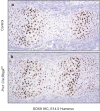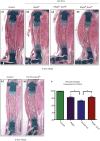Notch signaling controls chondrocyte hypertrophy via indirect regulation of Sox9
- PMID: 26558140
- PMCID: PMC4640428
- DOI: 10.1038/boneres.2015.21
Notch signaling controls chondrocyte hypertrophy via indirect regulation of Sox9
Abstract
RBPjk-dependent Notch signaling regulates both the onset of chondrocyte hypertrophy and the progression to terminal chondrocyte maturation during endochondral ossification. It has been suggested that Notch signaling can regulate Sox9 transcription, although how this occurs at the molecular level in chondrocytes and whether this transcriptional regulation mediates Notch control of chondrocyte hypertrophy and cartilage development is unknown or controversial. Here we have provided conclusive genetic evidence linking RBPjk-dependent Notch signaling to the regulation of Sox9 expression and chondrocyte hypertrophy by examining tissue-specific Rbpjk mutant (Prx1Cre;Rbpjk(f/f) ), Rbpjk mutant/Sox9 haploinsufficient (Prx1Cre;Rbpjk(f/f);Sox9(f/+) ), and control embryos for alterations in SOX9 expression and chondrocyte hypertrophy during cartilage development. These studies demonstrate that Notch signaling regulates the onset of chondrocyte maturation in a SOX9-dependent manner, while Notch-mediated regulation of terminal chondrocyte maturation likely functions independently of SOX9. Furthermore, our in vitro molecular analyses of the Sox9 promoter and Notch-mediated regulation of Sox9 gene expression in chondrogenic cells identified the ability of Notch to induce Sox9 expression directly in the acute setting, but suppresses Sox9 transcription with prolonged Notch signaling that requires protein synthesis of secondary effectors.
Figures






Similar articles
-
HES factors regulate specific aspects of chondrogenesis and chondrocyte hypertrophy during cartilage development.J Cell Sci. 2016 Jun 1;129(11):2145-55. doi: 10.1242/jcs.181271. Epub 2016 May 9. J Cell Sci. 2016. PMID: 27160681 Free PMC article.
-
Notch gain of function inhibits chondrocyte differentiation via Rbpj-dependent suppression of Sox9.J Bone Miner Res. 2013 Mar;28(3):649-59. doi: 10.1002/jbmr.1770. J Bone Miner Res. 2013. PMID: 22991339 Free PMC article.
-
Cartilage-specific RBPjκ-dependent and -independent Notch signals regulate cartilage and bone development.Development. 2012 Mar;139(6):1198-212. doi: 10.1242/dev.070649. Development. 2012. PMID: 22354840 Free PMC article.
-
Transcriptional Network Controlling Endochondral Ossification.J Bone Metab. 2017 May;24(2):75-82. doi: 10.11005/jbm.2017.24.2.75. Epub 2017 May 31. J Bone Metab. 2017. PMID: 28642850 Free PMC article. Review.
-
Transcriptional mechanisms of chondrocyte differentiation.Matrix Biol. 2000 Sep;19(5):389-94. doi: 10.1016/s0945-053x(00)00094-9. Matrix Biol. 2000. PMID: 10980415 Review.
Cited by
-
Bone biomaterials and interactions with stem cells.Bone Res. 2017 Dec 21;5:17059. doi: 10.1038/boneres.2017.59. eCollection 2017. Bone Res. 2017. PMID: 29285402 Free PMC article. Review.
-
Function and regulation of transforming growth factor β1 signalling in antler chondrocyte proliferation and differentiation.Cell Prolif. 2019 Jul;52(4):e12637. doi: 10.1111/cpr.12637. Epub 2019 Jun 6. Cell Prolif. 2019. PMID: 31168899 Free PMC article.
-
Histone demethylase LSD1 is critical for endochondral ossification during bone fracture healing.Sci Adv. 2020 Nov 4;6(45):eaaz1410. doi: 10.1126/sciadv.aaz1410. Print 2020 Nov. Sci Adv. 2020. PMID: 33148658 Free PMC article.
-
The growth plate: a physiologic overview.EFORT Open Rev. 2020 Sep 10;5(8):498-507. doi: 10.1302/2058-5241.5.190088. eCollection 2020 Aug. EFORT Open Rev. 2020. PMID: 32953135 Free PMC article. Review.
-
Molecular characterization of mesenchymal stem cells in human osteoarthritis cartilage reveals contribution to the OA phenotype.Sci Rep. 2018 May 4;8(1):7044. doi: 10.1038/s41598-018-25395-8. Sci Rep. 2018. PMID: 29728632 Free PMC article.
References
-
- Kronenberg HM. Developmental regulation of the growth plate. Nature 2003; 423: 332–336. - PubMed
-
- Foster JW, Dominguez-Steglich MA, Guioli S et al. Campomelic dysplasia and autosomal sex reversal caused by mutations in an SRY-related gene. Nature 1994; 372: 525–530. - PubMed
-
- Wagner T, Wirth J, Meyer J et al. Autosomal sex reversal and campomelic dysplasia are caused by mutations in and around the SRY-related gene SOX9. Cell 1994; 79: 1111–1120. - PubMed
Grants and funding
LinkOut - more resources
Full Text Sources
Other Literature Sources
Research Materials

